Physical Address
304 North Cardinal St.
Dorchester Center, MA 02124
Flexor tendon injuries in the hand are common and surgically challenging. Verdan and Michon sent shock waves through the scientific community in the 1960s when they recommended primary repair, which to this day remains the standard treatment for these injuries. Kleinert then improved functional outcomes by proposing early protected mobilization. Prior to this, however, in the 1930s, Sterling Bunnell had taken the position that primary repair of flexor tendons in “no man's land” was destined for failure and that grafts were preferable. The complete turnaround in techniques and the radical transformation in surgical outcomes that followed were possible thanks to numerous studies regarding tendon healing, biomechanics and suture techniques.
Flexor tendon injuries should be considered true surgical emergencies because the quality of the tendinous stump changes in a few weeks. Furthermore these lesions are often associated with neurovascular injuries that do not tolerate significant delays in treatment. Restoring the digital vasculature leads to better tendon healing and preservation of the gliding surfaces among other positive effects. Repairing the nerve restores pulpal sensibility, which is essential for the functioning and integration of fingers.
Lacerated tendons benefit the most from this approach, which delivers functional results that see the patient return to work between the seventh and ninth postoperative week. The primary suture is a meticulous and carefully considered technical procedure performed by a surgeon who has received training and instruction in rehabilitation methods. A failure of primary repair, however, leads to long-term incapacitation ranging from 6 months to a year, with a poor clinical outcome that at times requires multiple repeat surgeries ranging from simple tenolysis to tenoarthrolysis and two-stage grafting or even amputation. Furthermore, the damage done to the digital fibrous sheath by an inadequate primary surgery greatly complicates repeated interventions.
Functional issues and socioeconomic implications demand that this surgery be entrusted to surgeons who are specifically trained in these techniques, capable of repairing the associated lesions in a timely manner and able to coordinate subsequent rehabilitation.
The finger flexor tendons are part of the muscle-tendon system termed extrinsic because they originate in the forearm as opposed to the intrinsic muscles, which are all located in the hand.
Knowledge of the anatomy of the flexor tendons leads to the definition of topographic zones that substantially alter the treatment according to the level of injury. It is the classification of the International Federation of Societies for Surgery of the Hand (IFSSH) that has been adopted. It succeeds that of Verdan and Michon of 1961, which had been widely used. The IFSSH classification divides the fingers into five zones and the thumb into three ( Fig. 10.1 ).
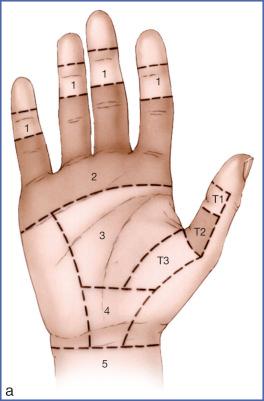
Zone 1 lies between the distal insertion of the flexor digitorum superficialis (FDS) tendon and the distal insertion of the flexor digitorum profundus (FDP) tendon, which inserts at the base of the distal phalanx. At this level the deep flexor tendon is unaccompanied in the flexor sheath and consists of two fascicles joined on their deep aspect. It is maintained in its path by two annular pulleys (A4 and A5) and a cruciform pulley (C3). The short vincula of the FDP and the palmar plate of the distal interphalangeal (DIP) joint are also located in this zone. This zone has been divided into three by Moiemen and Elliot. This classification has no real prognostic value, but it does provide insight into the possible methods of repair.
Zone 1a corresponds to the distal insertion and adjacent 7 mm up to the distal part of A5. The distal tendon stump is too short for a suture to obtain a good hold, and the main challenge here is the quality of the tendon anchor.
Zone 1b is located between 1a and the entrance under the A4 pulley. Suture is possible in this zone, the flexor sheath is wider and the tendon stump is of a decent length.
Zone 1c corresponds to the passage of the FDP under A4; this is a zone where suturing is demanding and difficult, as is the case for zone 2.
Zone 2 is Bunnell's “no man's land” and Verdan and Michon's zone 2, which begins at the entrance of the flexor sheath and ends at the middle part of the middle phalanx where the FDS is inserted. The flexor sheath is an inextensible osteofibrous tunnel formed dorsally by the periosteum of the first two phalanges as well as by the palmar plates of the metacarpophalangeal (MCP), proximal interphalangeal (PIP) and DIP joints. Palmarly, one finds the annular pulleys A1, A2, A3 and cruciform pulleys C1 and C2 that maintain the superficial and deep flexor tendons against the skeleton.
At the base of the proximal phalanx the FDS divides into two slips that become lateral then dorsal relative to the deep flexor. At the PIP joint the two slips exchange fibers, form the Camper chiasm and then insert in the middle part of the middle phalanx. In the tunnel the flexor apparatus is enveloped by a synovial sheath, promoting both its gliding and its nutrition. The correspondence between the sheath (pulley apparatus) and the content (tendons) is paramount for tendon movement, and depending on the movements performed, the FDP glides relative to the FDS. The suture must be technically perfect and the tendon excursion restored as fast as possible.
Zone 3 is demarcated by the distal edge of the carpal ligament and the distal palmar crease. It is a loose zone surrounded by paratenon, with the exception of the tendons of the little finger that travel in the ulnar synovial sheath. The lumbrical muscles are attached proximally at this level.
Zone 4 is the carpal tunnel that contains nine finger flexor tendons, as well as the median nerve, which is most superficial and in direct contact with the carpal ligament. It is a true pulley. The tendons are surrounded at this level by a synovial sheath that usually emanates from the cubital side.
Zone 5 is the musculotendinous junction, which is found at the level of the lower middle-third of the forearm and is the proximal limit of zone 5; distally it ends at the inlet of the carpal tunnel. From superficial to deep the FDS tendons are found—middle and ring finger then index and little; the deepest layer holds the deep flexor tendons and the flexor pollicis longus (FPL).
At this level the flexor tendons have a substantial excursion of 60–70 mm when the wrist is in dorsiflexion. This excursion is facilitated by a loose paratendon.
A single extrinsic tendon is responsible for thumb flexion: the FPL. It travels in three specific zones—T1 to T3—according to the IFSSH nomenclature, and two zones common to the long fingers, zones 3 and 4.
Zone T1 is situated between the insertion of the FPL on the base of the distal phalanx and the distal edge of the oblique pulley. The A2 pulley is located here.
Zone T2 corresponds to the passage of the tendon under the oblique pulleys and A1, with the latter being the most important.
Zone T3 is the deep passage of the FPL in the palm where it turns on the trapezium and then finds its way between the two heads of the flexor pollicis brevis muscle. In zone T1 the excursion is 12 mm and can reach 35–40 mm in zone 5.
Synovial sheaths are essential for the nutrition and gliding of the flexor tendons. These sheaths are sealed and closed at their ends, creating a cul-de-sac whereby the parietal layer lines the digital canal and the visceral layer adheres fully to the tendon. Between these two sheets the synovial sheath creates notable mesotendons called vinculae that participate in nutrition of the tendon. The index, middle and ring fingers have an individual sheath that occupies the digital canal of each of the fingers. Usually the FPL has its own sheath from zone 4 to zone T1, just like the sheath of the little finger, which also wraps around the other tendons of the long fingers in zone 4. There are, however, substantial variations in the distribution of the sheaths, particularly the communications between the sheaths of the thumb and little finger, which explains the formation of phlegmons in the shape of a horseshoe.
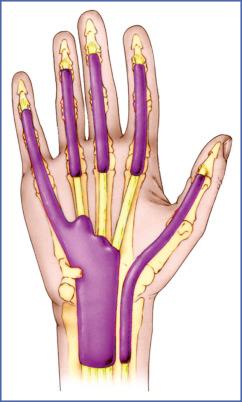
The pulleys are essential for complete flexion of the fingers because they maintain the flexor apparatus against the skeleton. By controlling the action of the tendons, they convert the force and the tendon movement into substantial and precise angular joint movements. Loss of the pulleys brings about a bowstring phenomenon that increases power but substantially reduces the digital range of motion. Doyle defines these pulleys as slips of thick fibrous tissue of varying width and configuration that strengthen the synovial sheath.
The anatomic study by Doyle and Blythe refers to this. They distinguish five annular pulleys and three cruciform ones to which the palmar fascia pulley and the pulley formed by the carpal ligament must be added.
The palmar fascia pulley is situated proximal to A1 and is fastened on either side of the sheath by sagittal fibers, which are continuous with the intermetacarpal transverse ligament. This neopulley, also called A0, has a real mechanical role; it is what replaces the A1 pulley when the latter has been cut.
The A1 pulley is situated opposite the MCP joint. It is very substantial, with an average length of 8 mm.
The A2 pulley is almost continuous with the A1 pulley. Its mechanical function is essential. It is attached to the bone at the proximal portion of the proximal phalanx over a length of 17 mm.
The C1 cruciform pulley follows on from it to the neck of the proximal phalanx.
The A3 pulley is a narrow annular pulley attached over 4 mm on the palmar plate of the PIP joint. It allows the tendon to be guided between A2 and A4, thereby avoiding too much of an angulation in the PIP joint flexion position. It is of little consequence if it is severed on its own.
The C2 pulley follows on from it and is attached to the proximal portion of the middle phalanx.
The A4 pulley, attached to the middle phalanx shaft, is a biomechanically important pulley because it is responsible for the function of the deep flexor on the DIP joint.
The C3 cruciform pulley is attached opposite the neck of the second phalanx.
The A5 pulley is anchored to the palmar plate of the DIP joint over an average length of 4 mm.

The main pulleys A2 and A4 are the critical ones in ensuring a nearly complete flexion of the finger, and they must be routinely preserved. They resist large forces directed anteriorly, as shown quite well by pulley ruptures among climbers. Even so, some recent biomechanical studies raise the possibility of partial excision of A2 or A4 without a substantial functional loss.
The secondary ring pulleys A1, A3 and A5 move slightly in the palm upon digital flexion owing to anterior translation of the palmar plates, which allow the tendon moment arm to be increased (and hence power) in the flexion position.
The A1 and A4 pulleys are the most robust and can sustain forces of 80 and 40 kg, respectively.
As for the cruciform pulleys, they have a junctional role between the annular pulleys and collapse like an accordion when the digit is flexed. Upon flexion, they are transformed into a ringlike structure by compression of their interlaced cruciform fibers. Recent biomechanical studies have assigned a bit more importance to C1, which seems to be a more important component than A3 in preventing the bowstring phenomenon.
The digital fibrous sheaths in general and the annular pulleys in particular warrant being given a high level of attention during all flexor surgery; they play an important role in the course of the tendon and quality of the final outcome. They must hence be spared by an approach that is achieved preferably by a layered fenestration (particularly for tenolysis). In cases of substantial injuries (particularly those involving successive pulleys) they will be sutured or reconstructed and eventually protected during active rehabilitation.
Next to each joint of the thumb, there is an annular pulley—A1 at the MCP joint and A2 for the IP joint. The oblique pulley intersects the shaft of the proximal phalanx. It sometimes displays the shape of an annular pulley at its most proximal part. Together with the A1 pulley, it is the most important pulley in biomechanical terms.
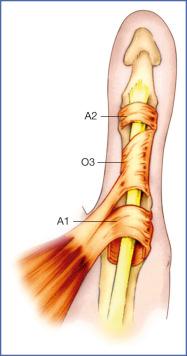
The flexor tendons have a double nutrition system, with direct vascularization on the one hand and an imbibition system from synovial fluid on the other.
The flexor tendons are vascularized at both ends by their muscle and bone insertions, but this only ensures survival of the tendons over a few centimeters.
In their extrasynovial segment, the vascularization wraps around in a loose and reticulated peritendinous tissue.
In the interior of the digital canal the vessels travel along to the dorsal aspect of the tendons through the vinculae, each of the superficial and deep flexors being connected to both a short and long vincula ( Fig. 10.5 ). Vascularization comes from retrotendinous transverse diaphyseal arteries, which themselves emanate from the digital arteries of the fingers. Respect for the vinculae is essential for proper nutrition of the tendons and hence for optimal healing. Nutrition of the deep flexor tendon is jeopardized when it is avulsed, because the vincular is also torn off.
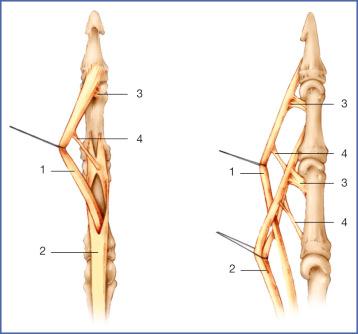
Tendon vascularization is unequal both longitudinally and in cross section. The vascular supply is dorsal and the palmar aspect is sometimes avascular, particularly at the level of the decussation of the two tendons. Longitudinally the vascularization is abundant regarding the vinculae but scarce away from this and also at the annular pulleys, owing to the pressure they exert on the tendons.
These anatomic findings have surgical consequences in the sense that care must be taken regarding vinculae and transverse diaphyseal anastomoses. The digital arteries that feed them should therefore be repaired routinely. Exploration of a wound suspected of having injuries to the flexors must hence preserve the posterior connections of the collateral arteries. The flexor tendons should be extracted atraumatically to avoid all further injury. In the case of avulsion with substantial retraction, retrieval of the tendon should be attempted without causing a vincular avulsion. Finally, sutures should preferentially be situated on the palmar surface of the tendon to avoid ischemia. This logical deduction is, however, counterbalanced by biomechanical studies that show that the attachment of the suture is strongest in the posterior position.
Synovial fluid facilitates the gliding of the tendon but also its nutrition through a phenomenon of diffusion and perfusion. This is the anterior zone of the tendon, which is avascular and benefits most from the diffusion of synovial fluid. This flows between the collagen fibers to fuel the metabolism of tenocytes and then drains through the dorsal vascular system. This synovial pump mechanism described by Weber justifies repair of the synovial sheath when possible and early protected mobilization to improve imbibition, nutrition and therefore tendon healing.
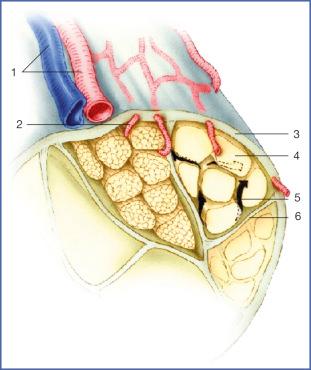
The tendon healing mechanism is complex and has been the subject of numerous studies. Healing occurs through two mechanisms: one extrinsic, which corresponds to fibroblastic invasion of the repaired zone, and the other intrinsic, which is due to the tendon's own ability to heal. A very large number of animal experiments have been performed (Hsu and Chang ), and they have allowed for better understanding of the synthesis of collagen I and II (Russell and Manske, Berglund et al. ), the migration of fibroblasts from the edge of the tendon to the central zone for repair (Jones et al. ) and the importance of fibroblast growth factor (FGF) and transforming growth factor (TGF)-β. Using dogs, Boyer et al. showed an increase in vascular endothelial growth factor (VEGF) over a 1-week period starting 7 days following the tendon repair. This most likely improves vascularization in the zone undergoing healing. Dahlgren et al. evaluated the effect of insulin-like growth factor (IGF) on horse tendon. It was found to increase the production of collagen, promote the robustness of the healing and decrease tissue edema. Tang confirmed the production of collagen I and cell proliferation in rabbits by the action of FGF. Gelberman et al. have shown that injection of platelet-derived growth factor (PDGF) BB at the level of the site of tendon repair improved function from the third week onward in dogs.
This was considered, incorrectly, by Potenza to be the only means of healing the tendon. This fibroblastic invasion of hypovascularized tendon by better vascularized surrounding tissues generates adhesions. In the digital canal, adhesions lead to a loss of function that requires a secondary tenolysis. It was based on this observation that Bunnell and Boyes advocated abandoning primary suturing in zone 2 to entrust tendon repair to a graft.
In reality, even if this fibroblast colonization with adhesions seems inevitable, it should not impede primary repair, as shown by Verdan and Michon. What helps to limit extrinsic fibroblast colonization is the rigor of the surgical technique, which must avoid damaging the epitendon and the digital canal by instrument maneuvers while searching for the tendon end. The suture must be as perfect and smooth as possible, using a noninflammatory absorbable suture material and allowing a nonischemic axial suture.
Restoration of the epitendinous seal helps to limit the formation of these adhesions. Early immobilization protocols are also indispensable to reduce the mechanical effects of adhesions.
We have Lundborg to thank for perfectly demonstrating that a completely severed tendon deprived of all vascular supply is able to heal without adhesions with the mere supply of synovial fluid. This healing comes about by proliferation of fibroblastic cells from the tendon or by differentiation of adjacent cells migrating toward the lesion, and it is accompanied by collagen synthesis.
Initially there is promotion of collagen III synthesis, after which the combination of local chemical factors (cytokines, metalloproteases, TGF-β) and mechanical stresses lead to remodeling of the zone undergoing healing.
It should be pointed out that both mechanisms of intrinsic and extrinsic healing will coexist in different proportions, depending on the nature of the trauma, extent of the surgery, type of repair and postoperative rehabilitation process.
Indeed, mobilization favors intrinsic healing by the relative movement of sutured tendons to each other and in relation to the synovial sheath. Resistance to this movement is very weak in its natural state, thanks to lubrication by synovial fluid and the surface coating of the tendon. Thus a tendon graft using an extrasynovial tendon, which has a less specialized surface, is more subject to abrasion and hence to adhesions.
As for tendon sutures, they result in much greater friction, because the surface becomes even more irregular. The causes of resistance to excursion are multiple. They can be linked to the tendon itself as a result of edema of the injured zone and also by formation of a tendon callus. The type of suture used, even if executed perfectly, is associated with friction that depends on the chosen technique (eg, the presence of knots on the surface of the tendon is irritating to the sheath and may cause catching of the repair, particularly if they are placed anteriorly). Transverse throws of the knots increase resistance in accordance with their number. The situation is even worse if the suture is not precise. This can cause mushrooming if the axial suture is too tight, or on the contrary a gap leading to edema with swelling of the stumps or even blockage of the passage through a pulley.
The rehabilitation protocol also exerts an influence. Passive mobilization allows tendon displacement of 3–4 mm but tolerates resistance to excursion poorly, which can lead to an attachment with plication of the tendon without actual mobilization of the suture. As such, a suture with a low friction coefficient is indispensable. Active mobilization acts to prevent moderate attachments but with more substantial stress on the repair, particularly because the digital edema and posttraumatic joint stiffness impose a more substantial traction than normal to create active movement. The suture will have to be very resistant in this case.
The concept of Amadio's “safe zone” illustrates this equilibrium. On the one hand, the actual resistance of the repair to cyclic stresses in vivo is in fact considerably less than its maximal resistance in vitro, because the rupture is triggered by the occurrence of a gap. On the other hand, a minimal level of stress needs to be applied to compensate for friction and bring about movement of the suture in the sheath. Ultimately over time, healing of the tendon strengthens the tendon, and the risk of adhesions will decrease. In the future there will probably be a reliance on tissue engineering of flexor tendons to improve the speed of intrinsic healing by direct onsite introduction of a matrix containing the required cellular and chemical components, and by the use of a semipermeable and lubricating layer around the suture to avoid adhesions.
A blend of all these factors will be involved. Intrinsic healing will prevail in cases involving a clean-cut wound that, once repaired in the most atraumatic and perfect way with a low-friction coefficient, will reconstitute the seal of the epitendon and synovial sheath and will allow early protected mobilization that will reactivate the synovial pump.
An accurate history is essential to determine the mechanism of injury for the flexor tendons. If the finger is flexed at the time of the accident, the distal end of the severed tendon is located at a distance from the skin injury once the finger is returned to a position of extension ( Fig. 10.7a ). During exploration of a wound involving the flexors, it is vital to undertake a rigorous inspection along the entire tendon or even to perform a precautionary extraction using a hook so as to not miss a separate lesion. The wound should be extended distally to expose the future site of the repair.
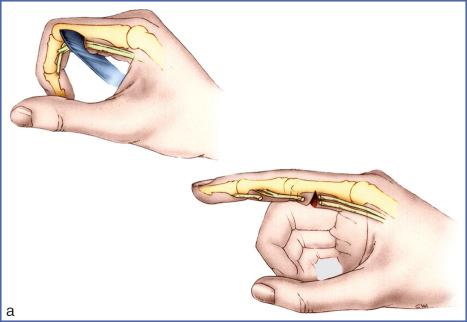
If the injury occurs with a finger in extension, the wound is extended proximally to retrieve the retracted proximal stump. If the muscle force applied at the time of the accident is significant, the proximal end of the flexor tendon retracts several centimeters proximally, creating significant trauma that tears all of the vinculae that are essential to the nutrition of the tendon.
One should determine the nature of the wounding agent and the degree of contamination. It is also important to differentiate ruptures from clean-cut lacerations, whose prognosis is more favorable.
Although the diagnosis of a flexor tendon injury is usually easy when it comes to cooperative patients, it is more difficult in children. It is advisable to carry out a full exploration of the wound, given the slightest doubt. This is especially true when it comes to partial tendon injuries, where the risks of secondary triggering, subsequent ruptures and scar adhesions are substantial if the lesion has not been identified and if there has been a simple emergency closure of the skin surface.
Clinical examination of the hand is usually sufficient to diagnose flexor tendon injury because the natural cascade of the fingers is interrupted. Normally with the wrist in a neutral position, the fingers flex progressively more from the index to the little finger. When the patient cannot be examined or is not sufficiently relaxed to exhibit this cascade phenomenon, the pressure test on the forearm is useful for identification of a distal tendon injury. When the tendons are in continuity, pressure exerted on the forearm muscle mass causes all of the fingers to flex. Partial tendon wounds, however, are not revealed by this test. The wrist tenodesis effect is also a reliable way to assess the flexor tendons for continuity. Extension of the wrist causes flexion of the fingers, whereas they will remain in extension when the tendon is cut.
When the patient is cooperating, active use of the tendons specifies the diagnosis. The deep flexor is tested ( Fig. 10.8a ) by keeping the MCP and PIP joints in extension and asking the patient to flex the DIP joint. The superficial flexor test requires that all fingers are kept in extension except for the examined finger; the patient is then asked to flex the finger. Only the superficial flexor can flex the PIP joint, because the deep flexor is blocked (see Fig. 10.8b ). In one-third of cases this test is negative with the little finger because the superficial tendon is either deficient or absent.
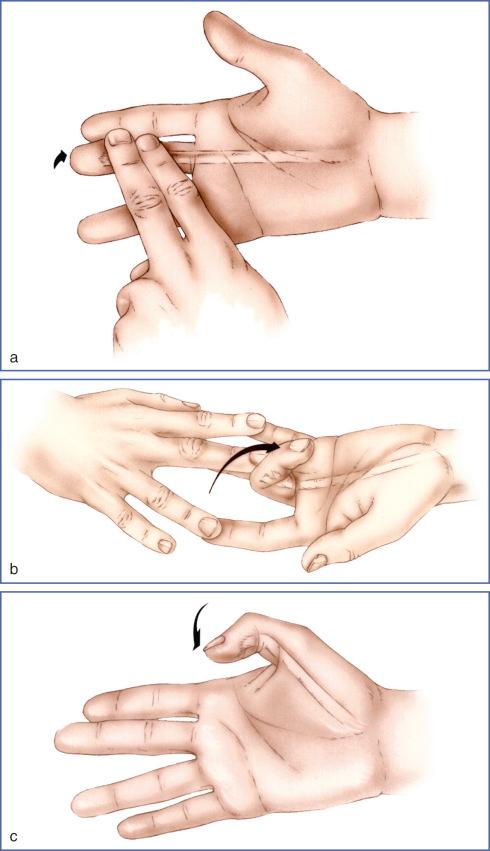
Examination of associated lesions, especially when there has been crushing or bruising, must be meticulous. All juxtaarticular or diaphyseal joint fractures can compromise the functional prognosis of the best tendon repair as the bone callus alters the anatomy of the digital canal and generates tendinoperiosteal adhesions. Simultaneous treatment of all the injuries is a prerequisite for early mobilization.
Digital nerve injury may be assessed by the two-point discrimination test, which is sometimes difficult to perform and interpret in an emergency. The depth of the wound, the injury-causing agent (eg, sheet metal, glass) and the position of the wound can be reasons to suspect a nerve lesion. Ultimately, integration of the finger requires the presence of an adequate sense of touch. The state of vascularization of the hand and fingers also determines the prognosis but mainly determines the degree of urgency for this flexor tendon wound.
Vascularization of the fingers must be reestablished to allow suitable healing of the tendon and a good digital trophism. It has been demonstrated that not repairing both the digital arteries of an injured finger permanently affects the functional outcome regardless of the quality of repair of the flexor tendons. Indeed, if the finger remains vascularized despite this lesion, the induced chronic hypovascularization will hinder tendon healing and digital trophism, which will compromise the outcome. We assess the state of vascularization of the fingers by pulp refill, by the capillary refill of the nail bed and particularly by performing a digital Allen test.
The clinical test to evaluate active flexion of the flexor pollicis longus is simple (see Fig. 10.8c ). It consists of asking the patient to do an IP flexion of the thumb. However, if the tendon is ruptured at the distal phalanx and the short vincula remains attached to the palmar plate, it is still possible to flex the IP joint, albeit without force. This is why the clinical test of the flexor pollicis longus should be carried out against the resistance of the examiner's finger.
Closed ruptures of the flexor tendons essentially affect the flexor digitorum profundus at its distal insertion on the phalanx. One should distinguish these from lesions that are of a rheumatoid origin or due to tendon attrition against a posttraumatic irregular surface, because the quality of the tendon is very different.
Jersey finger is an avulsion of a flexor tendon (FDP or more rarely FDS) that may or may not be associated with a fracture of P3. It is to the flexor what a “mallet finger” is to the extensor. It is encountered when a very substantial extension force is exerted on the DIP joint with an attempt to resist it by the FDP. Some sports are more conducive to these lesions, such as rugby, American football, and judo. Typically the accident occurs when the athlete tries to hold onto the shirt of an adversary who is getting away from them. Most often the lesion involves the ring finger, for well-described anatomic reasons. The insertion of the FDP is mechanically weaker on the ring finger, and the tendon interconnections are responsible for the lesser autonomy of this ray. On the other hand, in a semiflexed position this finger exceeds the apex of its neighbors and is more vulnerable to getting “hooked.”
The diagnosis is often obvious insofar as this pathology is well known in the professional sports community. Outside of this context, the diagnosis can be missed, compromising the treatment and expected outcome. The patient reports a compatible mechanism of injury, with a harsh “clicking” sensation. Inspection will search for bruising with edema. An attentive examiner will uncover loss of strong active flexion of the DIP joint upon testing and sometimes a limitation in PIP joint flexion when the tendon stump is stuck in the decussation of the FDS. The curled-up proximal stump can sometimes be palpated along the finger or at the MCP joint level, which implies rupture of the vinculae. Radiography is indispensible to identify a bone fragment on the anterior aspect of the finger. In case of doubt, ultrasound or magnetic resonance imaging can be ordered, but this should not under any circumstance defer treatment by more than a week.
The classification by Leddy and Packer distinguishes the range of lesions into three types, to which two additional types have subsequently been added ( Fig. 10.9 ). Type 1 is a retracted tendon avulsion at the level of the MCP joint; the entire vincular system is avulsed and the risk of rapid tendon retraction is considerable. With type 2 the tendon stump is blocked in the decussation of the FDS; the long vincula remains present and repair is still possible at 3 weeks or even longer. With type 3 an avulsion fracture of the FDP causes the bone fragment to be caught at the distal orifice of the flexor sheath, with preservation of the short vincula and little retraction. With the rare type 4 (described by Smith ) the tendon is disinserted from the bone fragment of a type 3. Finally, type 5 involves bone detachment and a transverse fracture of P3.
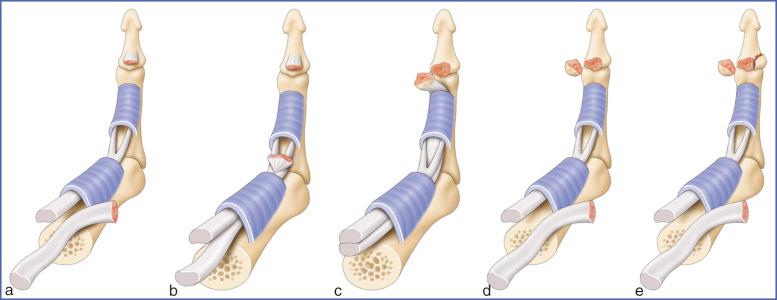
Treatment of these lesions must absolutely be done urgently, because secondary surgery is very difficult ( Table 10.1 ). The quality of the outcome and type of treatment will depend on the time interval and type of injury. In the case of a recent injury, repair is the treatment of choice. The reinsertion will be achieved by pullout or anchoring according to the preference of the surgeon ( Fig. 10.10 ).
| Type of lesion, modified Leddy-Packer | Lesion | Urgency of treatment | Prognosis | Emergency treatment |
|---|---|---|---|---|
| Type 1 | Pure disinsertion, retraction to the MCP | Urgent ++++ Substantial risk of retraction |
Tendon vascularization − Treatment delay Substantial and rapid FDP retraction Collapse of flexor sheath |
Reinsertion |
| Type 2 | Pure disinsertion, retraction to the FDS decussation | Repairable up to 3 weeks or even more, as a function of retraction | Tendon vascularization ± Treatment delay Retraction Collapse of distal flexor sheath PIP joint stiffness if long delay |
Reinsertion |
| Type 3 | Fracture of base of P3 Enclosure on A5 |
Little retraction, good tendon perfusion, distal repair often possible | DIP joint instability according to size of fragment DIP joint lesion, adding to stiffness Good vascularization |
Screw if a big fragment Reinsertion by pullout or by anchor if small fragment |
| Type 4 | Fracture of base of P3 + FDP disinsertion of enclosed fragment |
Urgent +++ | Cumulative type 1 and 3: DIP joint consequences FDP consequences |
Osteosynthesis or excision of fragment according to its size Tendon reinsertion by pullout suture |
| Type 5 | Fracture of base of P3 + Transverse fracture of P3 |
Urgent +++ | Same Immediate mobilization often not possible, with adhesions and poorer functional outcome |
Osteosynthesis of fracture by screws/plate Arthrodesis with slight flexion desirable Tendon reinsertion by pullout suture |
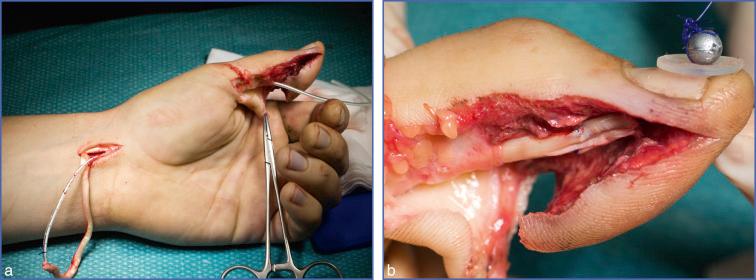
Treatment of these jersey finger lesions is more complicated when deferred, because tendon retraction and stump adhesions limit restoration of an adequate length for repair. Furthermore the empty digital sheath collapses, and the passage of the tendon becomes impossible. The functioning of the finger is evaluated carefully, particularly in terms of the PIP joint and the FDS. If the flexor sheath is open and the DIP joint functional, the treatment calls for a tendon graft in one or two stages according to the local tissue conditions. If the flexor sheath is collapsed and/or the DIP joint is fractured, with a preserved FDP and PIP joint, the most suitable treatment is a DIP joint arthrodesis. Abstention is an option if the DIP joint was the site of tenodesis or a “natural” capsulodesis and is not in a hyperextended position.
These appear gradually and painlessly by distension of the injured zone. Chronic pain is often reported in the preceding weeks. Full rupture occurs with additional strain. Tendon identification during repair may be complicated by pseudotendon formation and adhesions of the stumps to adjacent tendons. The repair often requires a graft.
The hook of the hamate serves as a reflection pulley and is a source of tendon abrasion for the flexors of the ring and little fingers ( Fig. 10.11 ). A graft is the treatment of choice. An alternative consists of performing a lateral tenodesis with adjacent flexors (ring and middle) distal to the flexor retinaculum, with a technique identical to the transfers for a paralyzed hand.
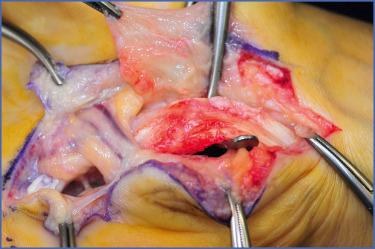
Become a Clinical Tree membership for Full access and enjoy Unlimited articles
If you are a member. Log in here